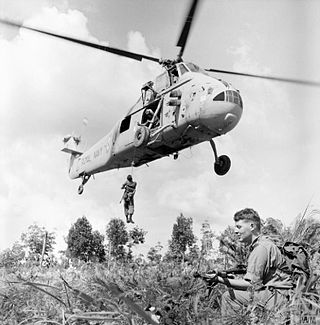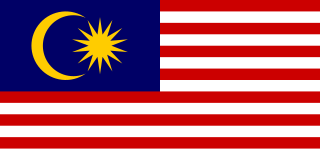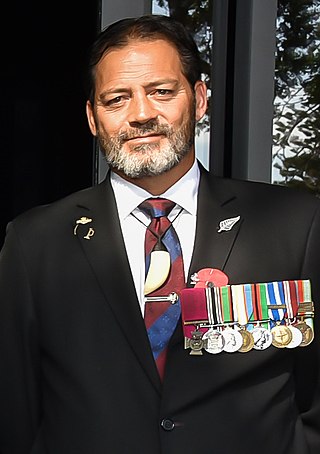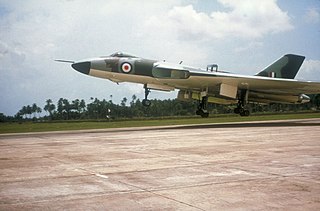Related Research Articles

The Indonesia–Malaysia confrontation or Borneo confrontation was an armed conflict from 1963 to 1966 that stemmed from Indonesia's opposition to the creation of the state of Malaysia from the Federation of Malaya. After Indonesian president Sukarno was deposed in 1966, the dispute ended peacefully.

Claret was the code name given to operations conducted from about July 1964 until July 1966 from East Malaysia across the border in Indonesian Kalimantan during the Indonesia–Malaysia confrontation. They were instigated by the Director of Borneo Operations (DOBOPS) Major General Walter Walker with the agreement of the British and Malaysian governments. Their purpose was to seize the initiative and put the Indonesians on the defensive instead of allowing Indonesian forces to be safely based in Kalimantan and attack when and where they chose. However, it was important not to cause the Indonesians to lose face and possibly escalate the conflict, or to enable Indonesia to present evidence of 'imperialist aggression', so Claret operations were highly classified and never publicised, although it seems that some British journalists were aware of what transpired. British casualties on Claret operations were publicly reported as being in East Malaysia.

The 1st New Zealand Special Air Service Regiment, abbreviated as 1 NZSAS Regt, is the special forces unit of the New Zealand Army, closely modelled on the British Special Air Service (SAS). It was formed on 7 July 1955. It traces its origins to the Second World War and the famous Long Range Desert Group that New Zealanders served with.

The Royal New Zealand Infantry Regiment is the parent administrative regiment and corps of regular and reserve infantry battalions in the New Zealand Army. It was originally formed in 1947 with a singular Regular regiment and multiple reserve regiments. Over time, the regiments were turned into battalions, the reserve units amalgamated and more regular units raised and disbanded. Currently, the Regiment currently consists of two regular and three reserve battalions. Throughout its existence, units raised in this regiment have served and deployed on operations in Malaya, Vietnam, Borneo and various United Nations peacekeeping operations.

The General Service Medal, is a campaign medal of the United Kingdom introduced in 1962 to replace both the General Service Medal (1918), as awarded to the Army and RAF, and the Naval General Service Medal (1915). The 1962 GSM was awarded until 2007, when it was replaced by the Operational Service Medal. In 2015 the General Service Medal (2008) was introduced.

New Zealand's involvement in the Vietnam War was highly controversial, sparking widespread protest at home from anti-Vietnam War movements modelled on their American counterparts. This conflict was also the first in which New Zealand did not fight alongside the United Kingdom, instead following the loyalties of the ANZUS Treaty.
The New Zealand armed forces saw action in Malaysia throughout the 1950s and 1960s, first as part of the British Commonwealth response to the Malayan Emergency, and then in defence of Malaysia in the Indonesia–Malaysia confrontation.

Bill Henry "Willie" Apiata, VC is a former corporal in the New Zealand Special Air Service, who became the first recipient of the Victoria Cross for New Zealand. He received the award on 2 July 2007 for bravery under fire during the War in Afghanistan in 2004, in which he carried a gravely wounded comrade across a battlefield, under fire, to safety.
Colonel Frank Rennie was a career soldier in the New Zealand Army, holding every rank between private and colonel, and founder of the New Zealand Special Air Service.

The Battle of Sungei Koemba took place during the Indonesia–Malaysia confrontation. Involving Australian and Indonesian troops, the battle consisted of a series of ambushes launched by the 3rd Battalion, Royal Australian Regiment, along the Sungei Koemba river in Kalimantan. The ambushes were part of the wider Operation Claret which involved cross-border operations by British-Commonwealth units from bases in Sarawak, penetrating up to 10,000 yards (9,100 m) into Indonesian territory with the aim of disrupting the movement and resupply of Indonesian forces and to keep them off balance.

The Indonesia–Malaysia confrontation was fought from 1962 to 1966 between the British Commonwealth and Indonesia. Indonesia, under President Sukarno, sought to prevent the creation of the new Federation of Malaysia that emerged in 1963, whilst the British Commonwealth sought to safeguard the security of the new state. The war remained a limited one however, and was fought primarily on the island of Borneo, although a number of Indonesian seaborne and airborne incursions into the Malay Peninsula did occur. As part of Australia's continuing military commitment to the security of Malaysia, Australian army, naval and air force units were based there with the Far East Strategic Reserve, mainly in the 28th Commonwealth Infantry Brigade Group.

Papakura Military Camp is a New Zealand Army military camp located in the Auckland suburb of Papakura North, in northern New Zealand. It is the home of the New Zealand Special Air Service.

Indonesia–New Zealand relations are foreign bilateral relations between Indonesia and New Zealand. Having common interests as democracies and neighbours in the Asia Pacific region, New Zealand and Indonesia are viewed as natural partners. Both countries are members of APEC. Indonesia and New Zealand officially established diplomatic relations in 28 June 1958. New Zealand has an embassy in Jakarta, and Indonesia has an embassy in Wellington.

No. 41 Squadron was a transport unit of the Royal New Zealand Air Force (RNZAF). The squadron was formed in 1944, and conducted transport flights in the south Pacific during World War II. It remained active after the war, and flew supplies to the New Zealand occupation force in Japan. Three crews from the squadron participated in the Berlin Airlift during 1948 and 1949, and one of its flights was temporarily based in Singapore from 1949 to 1951. From 1955 the entire squadron was stationed at Singapore, from where it participated in the Malayan Emergency, Indonesia–Malaysia confrontation and Vietnam War. Detachments of No. 41 Squadron were also based in Thailand from 1962 to 1965. The squadron was disbanded in 1977.

Leon Kristopher Smith, was a New Zealand Army soldier who was posthumously awarded the New Zealand Gallantry Decoration and the Charles Upham Bravery Award for his actions when attempting to resuscitate a mortally wounded colleague, while responding to an insurgent attack on the British Council Offices in Kabul, Afghanistan in 2011. Smith, who was a member of the New Zealand Special Air Service, was himself mortally wounded during a later operation in Afghanistan.
Brigadier Ian Hamilton Burrows was a senior New Zealand Army officer. He served with the New Zealand Special Air Service in Malaya in 1955 as one of the "originals" before going on to senior command positions in the New Zealand Army, culminating in his promotion to brigadier and appointment as Commander of Land Forces New Zealand in 1981.
This is an order of battle listing the British and Commonwealth forces involved in the Indonesia-Malaysia confrontation (1962–66).

The Indonesia–Malaysia confrontation began in early 1963 following Indonesia's opposition to the creation of Malaysia. In December 1964, a build-up of Indonesian forces on the Kalimantan border saw the British government commit significant forces from the UK-based Army Strategic Command and Australia and New Zealand deployed roulement combat forces from West Malaysia to Borneo in 1965–66.
The 2005 New Year Honours in New Zealand were appointments by Elizabeth II in her right as Queen of New Zealand, on the advice of the New Zealand government, to various orders and honours to reward and highlight good works by New Zealanders, and to celebrate the passing of 2004 and the beginning of 2005. They were announced on 31 December 2004, and included gallantry awards for actions in East Timor.
Karl Cummins is a New Zealand military officer and was the Commanding Officer of the New Zealand Special Air Service from 2012 to 2013. He was one of the subjects of the New Zealand Government's inquiry into Operation Burnham.
References
- 1 2 "No. 43856". The London Gazette (3rd supplement). 1 January 1966. p. 43.
- ↑ "Ao Hou, Te / The New World, No. 54". March 1966. p. 27. Retrieved 10 July 2013.
- ↑ Crosby, Ron (2009). NZSAS: The First Fifty Years. Viking. pp. 146–151. ISBN 978-0-67-007424-2.
- ↑ "No. 43837". The London Gazette (Supplement). 14 December 1965. p. 11682.
- ↑ Crosby, Ron (2009). NZSAS: The First Fifty Years. Viking. p. 168. ISBN 978-0-67-007424-2.
- ↑ Ball, Rhys (2009). The Platforms: An examination of New Zealand Special Air Service campaigns from Borneo 'Confrontation' to the Vietnam War, 1965-1971 (PDF). p. 85.
- ↑ Crosby, Ron (2009). NZSAS: The First Fifty Years. Viking. p. 262. ISBN 978-0-67-007424-2.
- ↑ McCabe, Roi (April 2010). "'Sour grapes' policy around military service wrankles" (PDF). Police News. Vol. 43, no. 3. p. 81. Retrieved 18 January 2015.
- ↑ "Wanganui rugby rep appearances (since 1944)" (PDF). Wanganui RFU. March 2014. Retrieved 18 January 2015.
- ↑ "Hauraki News "Whaka tangata kia kaha"" (PDF). No. 56. August 2009. Retrieved 10 July 2013.
- ↑ King, Alison (21 August 2008). "Recognition at last for veterans of Malaya war campaign". Bay of Plenty Times. p. 3.